Amazon Business Models Guide 2025
Download Amazon Seller Guide
This guide will help you get started, understand the basics of Amazon selling, and explain in simple words how it all works.
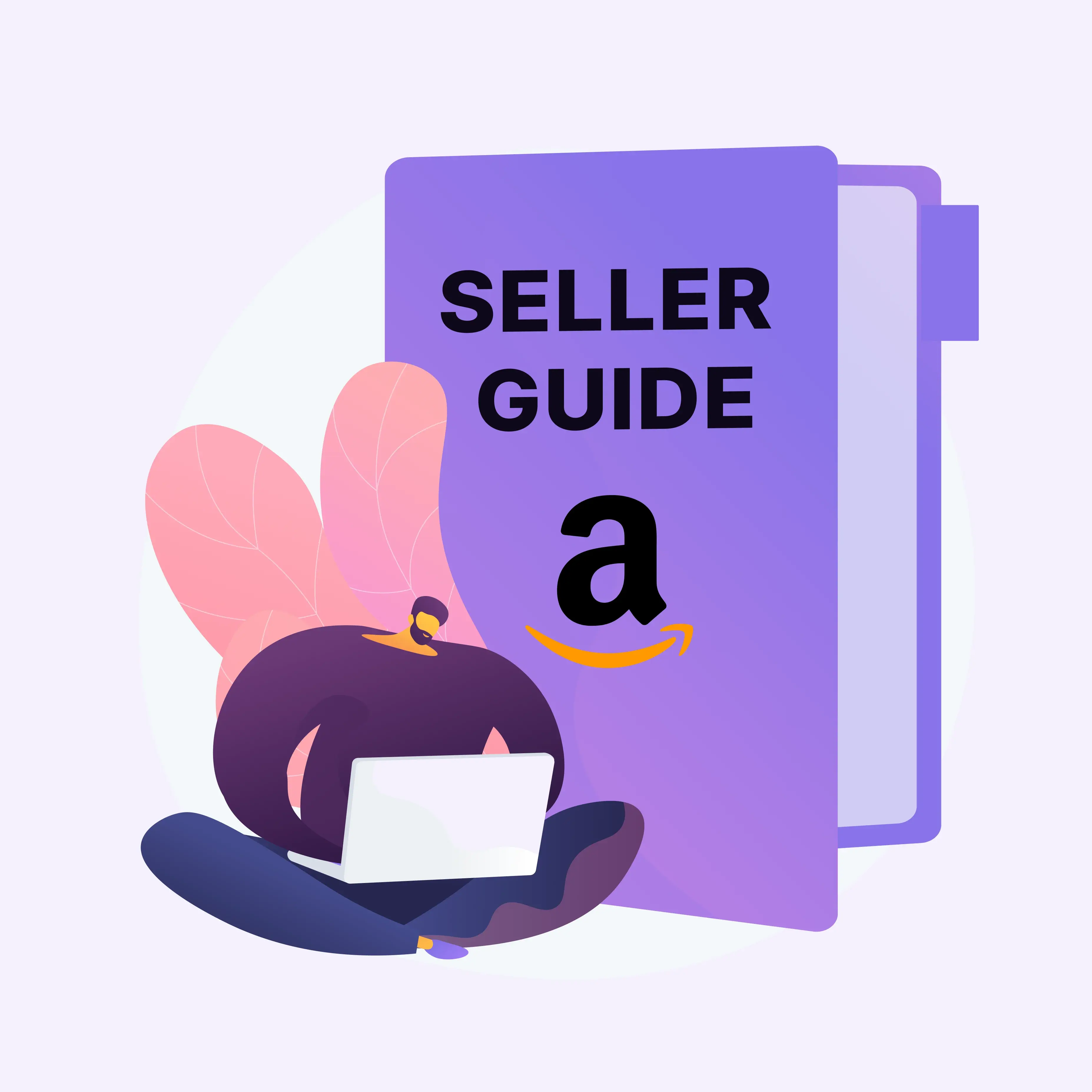
Unsure which Amazon business model suits you best – or if it’s time to switch? From private label to wholesale, dropshipping, online and retail arbitrage, each model has its own pros, cons, and income potential.
Understanding how Amazon business models work – and what kind of seller they’re best for – can make all the difference.
This guide breaks down every major Amazon business model, how they work, who they’re best for, and what it takes to win in each. Whether you're starting fresh or scaling up, you’re in the right place.
What Are Amazon Business Models?
.avif)
Before you sell anything on Amazon, you need to choose a business model. Think of a business model as the blueprint for how you’ll make money – what you’ll sell, where you’ll get it, and how you’ll turn a profit.
On Amazon, your business model shapes everything: startup costs, workload, marketing strategy, and long-term scalability. Pick the right one, and you’re set up for growth. Pick the wrong one, and even great products can flop.
So what Amazon business models are out there?
Types of Amazon business models
Broadly speaking, there are two categories: pure reselling and private label.
Reselling models
Reselling models include:
In these models, you buy products cheap (from suppliers or retail stores) and resell them on Amazon at a profit. You're not creating anything new – you’re just finding in-demand products that already sell well.
The beauty of reselling is that you can start quickly, with low risk. You don’t need to create new listings or invest in marketing. Just plug into existing demand and start flipping.
Private label
Then there's private label (PL) – which is kind of a hybrid. You're still selling products made by someone else (usually sourced from manufacturers), but you build your own brand around them.
That means you register your brand, create custom packaging and Amazon listings, promote your brand to drive traffic and reviews. It’s more work and more investment, but the rewards are bigger too. With a private label, you own the brand and your products are unique which means no direct competition.
Choosing between reselling and private label depends on your budget, goals, and risk tolerance – and we’ll help you figure that out in the next sections.
Note. Some people mention Amazon Handmade as a separate business model, but that's not entirely accurate. Handmade is actually a program, not a model – it’s a platform that helps artisans sell products they physically make themselves. It's similar to Merch by Amazon (where you sell your own designs), Amazon Kindle Direct Publishing (for self-published authors), or Mechanical Turk (where you offer services). These programs are more about how you sell something you've personally created, rather than the business strategy behind sourcing and reselling products.
Why Do Amazon Business Models Matter?
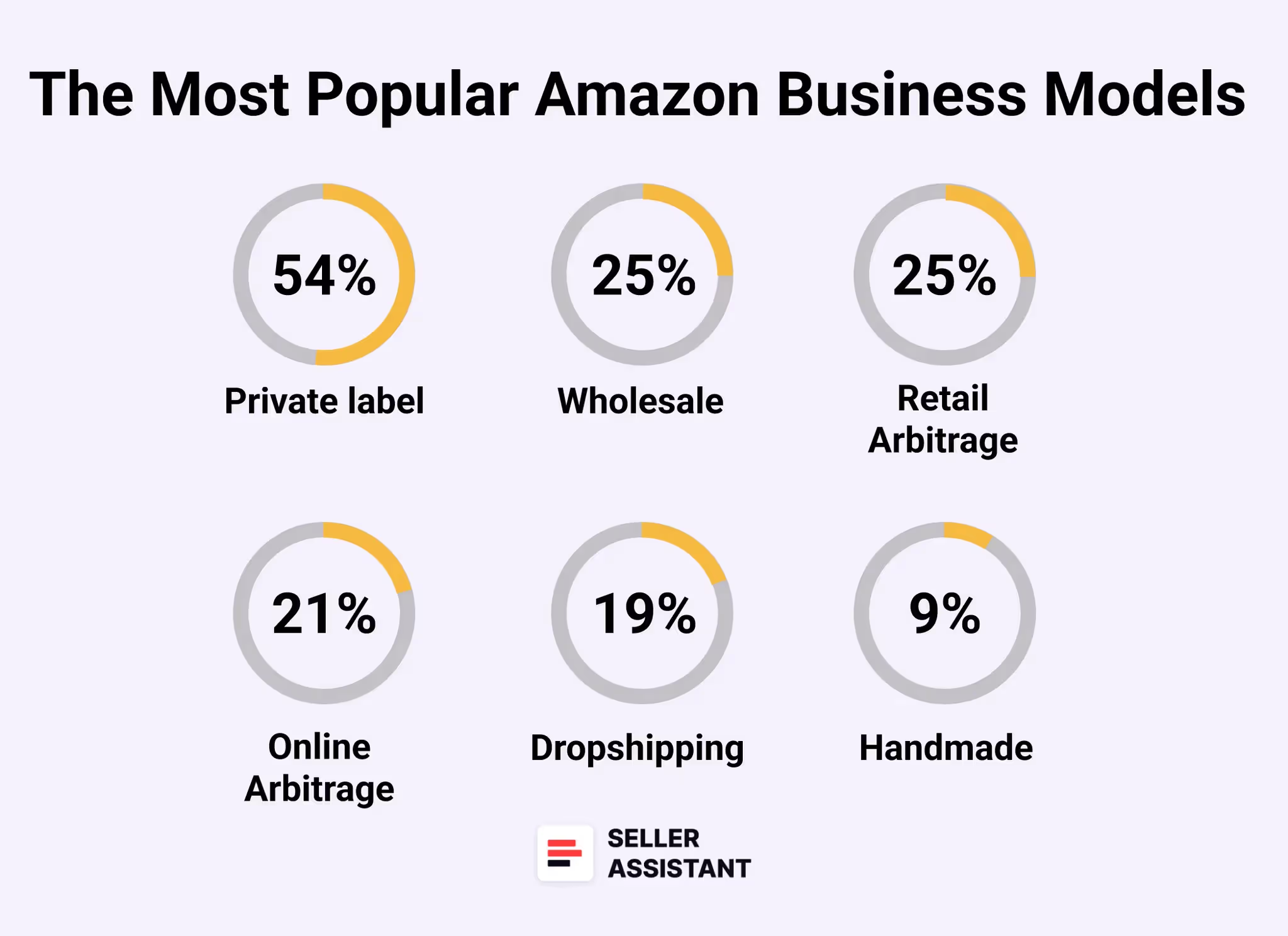
The Amazon seller business model you choose directly impacts the way you sell on Amazon. It defines the following essential parameters of the sales process.
Product type
The kind of products you want to sell largely determines the business model you will use and the way you will source and sell that product. With a private label, you create a brand of a popular product, while wholesale, arbitrage sellers, and dropshippers resell high-demand products.
Cases by business model
Private label
You design the brand and place it on the selected product, dictating what and how is branded, promoted, and sold.
Example: Selling custom-designed phone cases.
Online arbitrage
You find a popular product on Amazon, choose a supplier that offers it at a much lower price and offers discount, do product research with product sourcing tools like Seller Assistant to make sure you can sell on your seller account, it’s profitable and doesn’t have any risks. Then you source it, wait until it sells, and pocket the profit.
Example: Selling 100 units of garlic press which costs $30/unit on Amazon and $10/unit at the supplier after all discounts.
Sourcing channels
The business model you select largely determines where you source your product. Wholesale sellers buy them directly from brands or their distributors; online arbitrage sellers and dropshippers find them at other retailers, while retail arbitrage sellers roam brick-and-mortar stores.
Cases by business model
Wholesale
You directly negotiate and purchase popular products from brands, or their distributors, requiring larger upfront investments but potentially higher profit margins. You research a brand with Seller Assistant's Brand Analyzer to make sure it’s worth contacting. Then you reach out to a brand, get a wholesale price list, and analyze it with Seller Assistant's Price List Analyzer to find profitable low-risk deals. You source these items in bulk and sell them for a good profit.
Example: Buying large quantities of phone chargers directly from a brand.
Retail arbitrage
You source discounted products from liquidation or clearance stores, offering a wider variety but limited by what you find.
Example: Finding and reselling limited-edition toys.
Fulfillment strategy
Business model the way of fulfilling the order to the customer
Cases by business model
Dropshipping
Dropshipper finds a product and agrees with a supplier that they will deliver orders to Amazon customers. A supplier stores and ships products directly to customers, minimizing dropshipper’s inventory management but limiting control over quality and shipping.
Example: Finding a supplier for profitable kitchen décor items, listing them on Amazon, and when bought, supplier sends these items to the prep center. The prep center repackages the orders to ensure all third-party labels and packaging are removed, and sends them to customers.
Wholesale
You buy products in bulk from the established brand, selecting products from its existing offerings with Seller Assistant's Price List Analyzer. The brand delivers products to a prep center that preps them in accordance with Amazon’s requirements and sends them to Amazon’s fulfillment center. Then, Amazon delivers the order to the customer.
Example: Reselling well-known sports apparel brands.
Note. Seller Assistant is a comprehensive product-sourcing software that helps Amazon sellers quickly find high-profit deals. It combines three extensions: Seller Assistant Browser Extension, and IP-Alert Chrome Extension by Seller Assistant, and VPN by Seller Assistant, Amazon seller tools: Price List Analyzer, Brand Analyzer, Seller Spy, Bulk Restrictions Checker, and API integrations, and features: Side Panel View, FBM&FBA Profit Calculator, Quick View, ASIN Grabber, UPC/EAN to ASIN converter, Stock Checker, IP Alert, and Restrictions Checker.
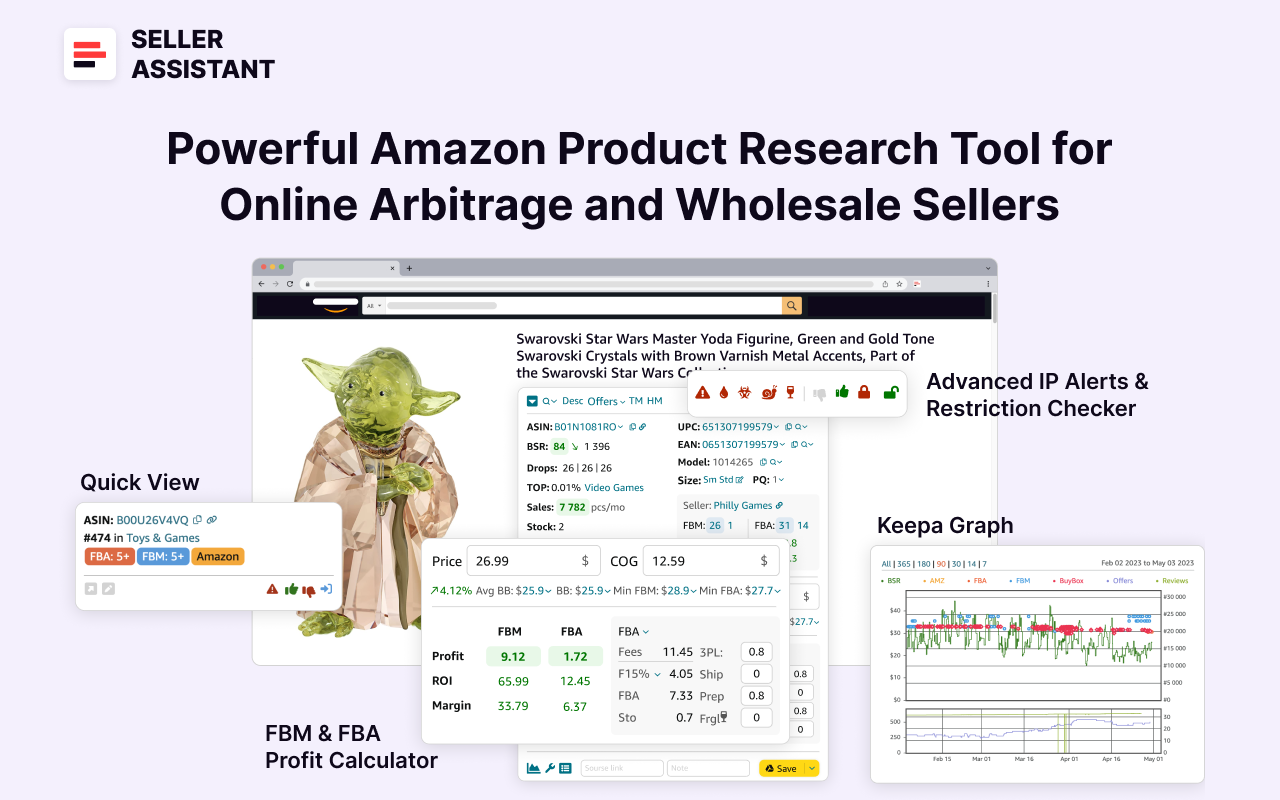
It offers a robust toolkit of over 20 features built to streamline every part of the sourcing process – from bulk scanning wholesale supplier sheets for high-margin leads to deep product research and advanced brand and competitor analysis. By using this FBA and FBM product sourcing software, you can easily identify products that have the potential to be sold well on Amazon.
Wholesale
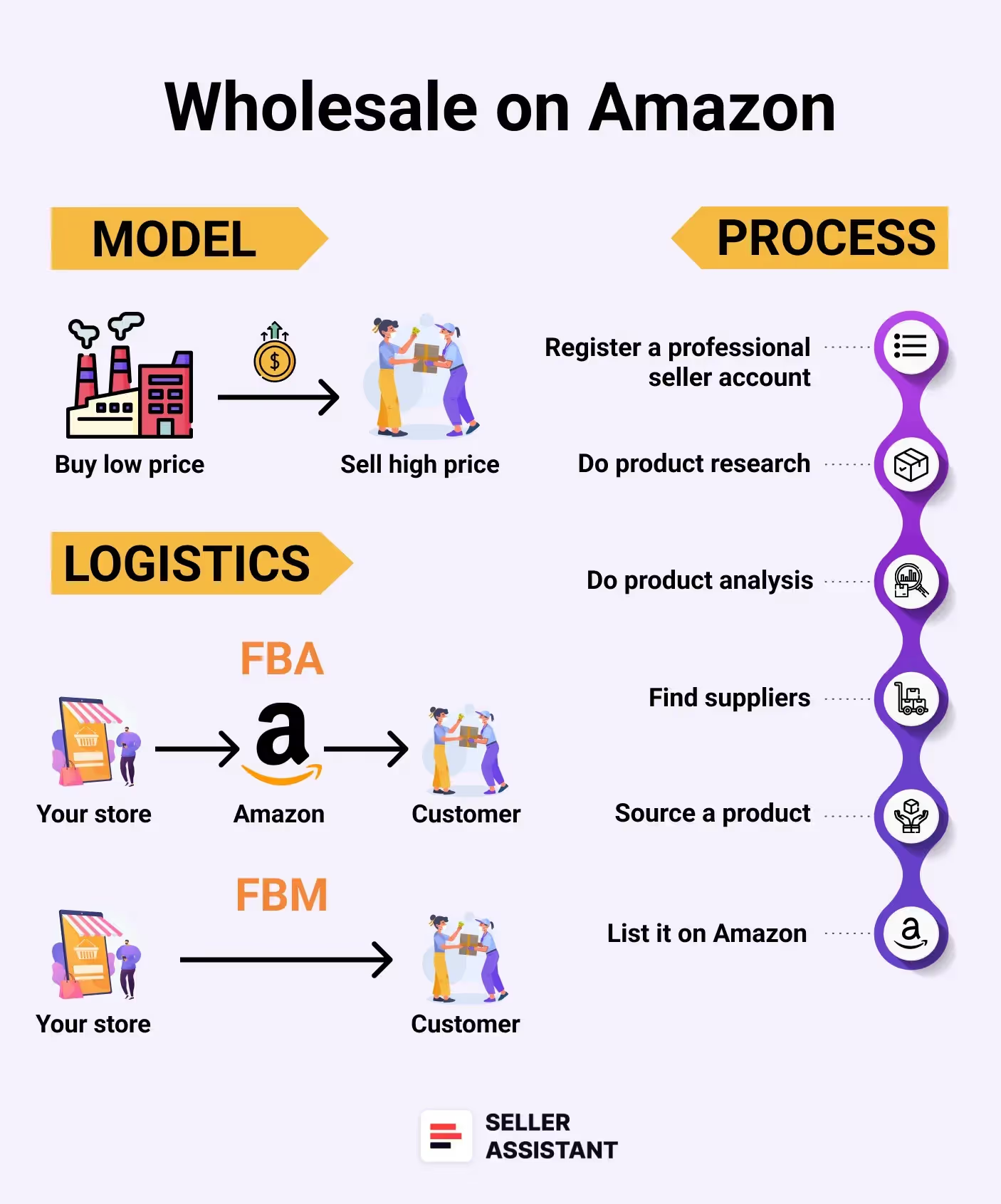
Wholesale is a business model where sellers purchase products in bulk at discounted rates – usually directly from brands or authorized distributors – and resell them on Amazon at retail prices for a profit. It’s one of the most straightforward ways to sell on Amazon because you’re dealing with already-established products that people are already searching for and buying.
How Amazon wholesale works
Here’s a breakdown of how the wholesale process works.
Step 1. Get a reseller’s permit
This allows you to buy inventory without paying sales tax.
Step 2. Pick a product category
Choose a niche based on demand, competition, and your interests.
Step 3. Find suppliers
Locate brands or distributors that offer the products you want to sell. Use Seller Assistant's Brand Analyzer to automate brand research and insights into its sales performance, competition levels, average pricing, and customer reviews.
Step 4. Vet the suppliers
Confirm their legitimacy through references, reviews, LinkedIn, or tools like Whois or ScamAdviser.
Step 5. Reach out and apply
Contact suppliers and submit an application to open a wholesale account.
Step 6. Request wholesale price lists
Get access to detailed wholesale pricing and stock availability.
Step 7. Analyze for profit and risks
Use product Seller Assistant's Price List Analyzer to identify profitable deals from the price list. Get in-depth product data, warnings, your selling eligibility, and apply filters to automate selecting the winning leads.
Step 8. Negotiate terms
Discuss pricing, order volume, and future deals.
Step 9. Place your first bulk order
Purchase inventory, typically starting at $1,000–$2,000 (or higher).
Step 10. List on Amazon
Add your offers to existing listings.
Step 11. Prep and ship
Use FBA or FBM to fulfill orders, following Amazon’s packaging rules.
Step 12. Sell and reorder
Once your products are sold out, reinvest the profit and reorder.
3 key insights for wholesale sellers
High profits require high capital
Wholesale is profitable, but you’ll need to invest a few thousand dollars upfront to see real returns.
Supplier relationships are everything
Your success depends on securing reliable, long-term partnerships with brands and distributors.
Thorough product research minimizes risk
Avoid low-demand, over-competitive, and risky deals by using price list scanning tools like Price List Analyzer and analyzing product history.
Pros and cons of Amazon wholesale
Pros of wholesale
.avif)
Fast to launch
You can start selling on Amazon wholesale in as little as six weeks. The biggest time commitment is opening suppliers and researching products.
High-profit potential
Many wholesale sellers earn 30%+ ROI by buying in bulk at lower costs. Profit margins grow as order volumes increase and supplier terms improve.
Predictable sales and cash flow
You’re reselling products with proven demand, so forecasting sales is easier. This creates steady, reliable revenue streams.
Scalable
Once you’ve built strong supplier relationships, scaling is just a matter of placing larger orders. There’s no need to reinvent your strategy each time you grow.
No listing creation or marketing needed
You sell products already listed in Amazon’s catalog by adding your offer to existing ASINs. Since the products are already popular, you don’t need to invest in promotion or advertising.
Cons of wholesale
.avif)
High upfront investment
Most wholesale suppliers require minimum orders starting at $1,000–$2,000 or more. That means you'll need solid starting capital to get moving.
Tough supplier access
Established brands often prefer working with known, vetted sellers. You’ll need to present your business professionally to get approved.
Listing competition
You’ll be sharing the Amazon listing with other sellers offering the same product. Price wars and Buy Box battles are common.
Time-consuming
Finding profitable products and negotiating with suppliers can take significant time. It’s a process that requires research, outreach, and patience.
Big loss risk if you choose poorly
If you invest in the wrong product or make a bad supplier deal, the financial impact can be serious. Unlike low-risk models, wholesale mistakes can cost thousands.
Startup cost
Estimated starting capital: $2,000–$5,000+ depending on product type, supplier MOQs, and your initial order size.
Online Arbitrage

Online arbitrage is a reselling model where sellers buy discounted products from online retail stores and flip them on Amazon for a profit. The strategy revolves around spotting pricing mismatches between Amazon and other retailers, allowing you to buy low and sell high – after accounting for Amazon’s fees.
How Amazon online arbitrage works
Online arbitrage is easy to start but demands smart product research and good judgment. Here's a step-by-step overview of how it works.
Step 1. Create an Amazon seller account
Register under an individual or professional plan to access Amazon Seller Central.
Step 2. Find potential deals
Search retail websites manually or use Seller Assistant's tools to discover profitable deals (we will discuss how to do it below).
Step 3. Do product research
Use tools like Seller Assistant Extension to check eligibility, profit margins, sales history, and product risks (IP complaints, hazmat, etc.).
Step 4. Decide quantity
Base your purchase on sales estimates and budget. Start small to avoid tying up cash in slow-moving inventory.
Step 5. Source products
Purchase from online stores using promo codes, cashback, and other savings strategies to maximize margins.
Step 6. List products on Amazon
Join existing listings or create new ones if your product isn’t in the catalog.
Step 7. Choose a fulfillment method
Decide between Fulfillment by Amazon (FBA) or Fulfillment by Merchant (FBM).
Step 8. Set competitive pricing
Use repricing tools to stay in the Buy Box and maintain profit.
Step 9. Sell, monitor and scale
Get money from sold products. Track sales, manage stock, and use automation tools to grow your operations over time.
3 Key insights for online arbitrage sellers
Winning product is key
Focus on items with high demand, low competition, and no selling restrictions to minimize risk and maximize sales.
Product research takes time
Finding the right products requires digging into data, but using tools like Seller Assistant can help speed things up.
Check for restrictions and risks
Always ensure the product is eligible for your account, and check for hidden risks like IP complaints, hidden risks (like hazmat, heavy and bulky, fragile, meltable flags), or Amazon policy issues. Use Seller Assistant’s IP Alert and Alerts and Flags feature.
Pros and cons of online arbitrage
Pros of online arbitrage

Low startup costs
You can start with as little as $500 since you’re not required to buy in bulk or work with suppliers.
Easy to launch
Setting up an account and sourcing products online can be done in 2–3 months, even with minimal experience.
Work from anywhere
Sourcing can be done entirely online, so you don’t need to visit physical stores or warehouses – ideal for remote work.
Access to broader inventory
You’re not limited by local store stock – you can tap into national or even global retailer inventories for more deal opportunities.
Flexible and scalable
Start small and reinvest profits to grow. Over time, sourcing and pricing can be automated with tools like Seller Assistant to scale efficiently.
Cons of online arbitrage
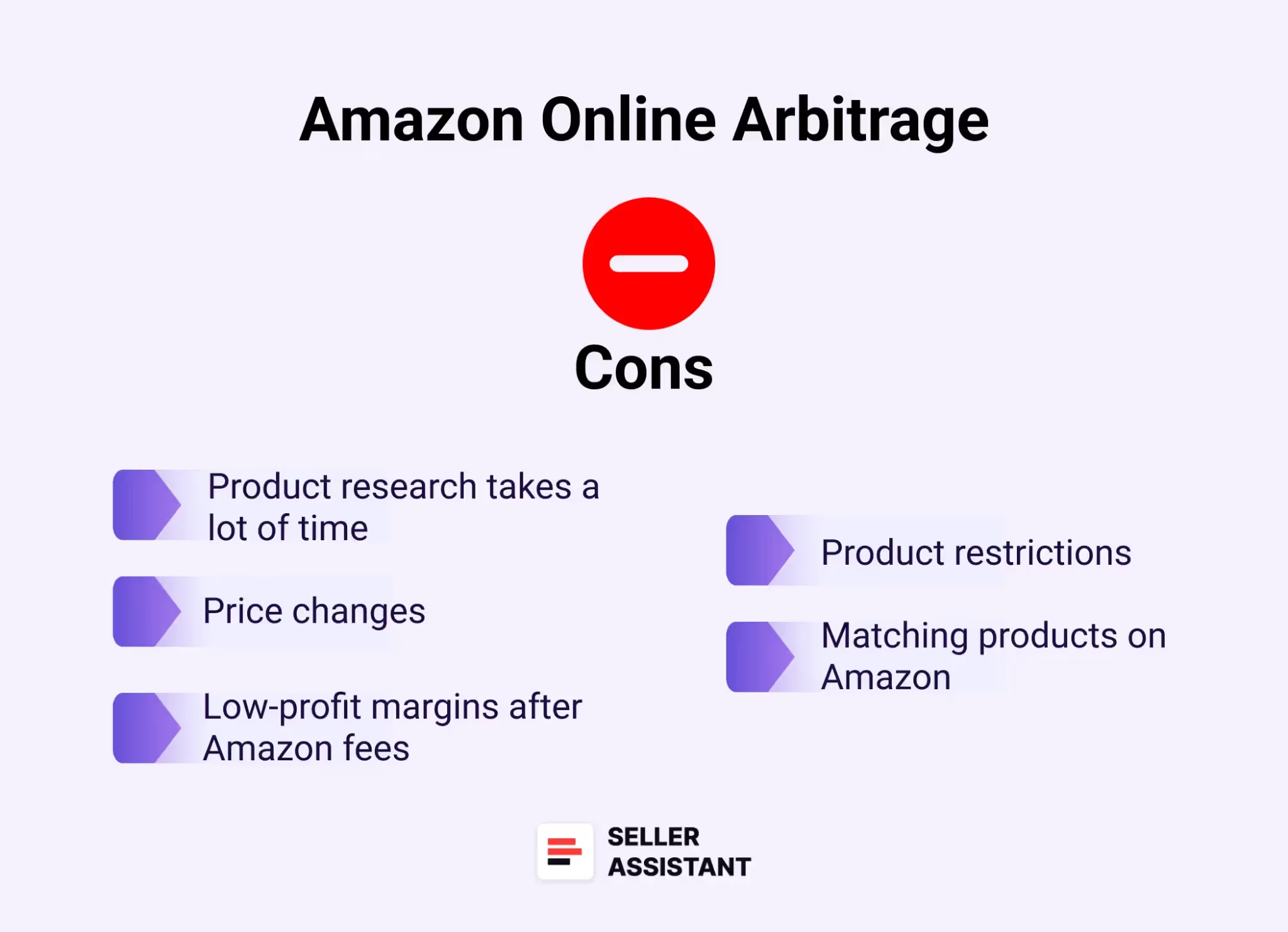
High competition for deals
Popular products are often targeted by many sellers, which can reduce your margins and sell-through speed.
Time-consuming research
Finding good products takes effort. Even with tools, identifying deals that are both profitable and compliant takes daily attention.
Unstable profit margins
Due to price fluctuations and seller competition on listings, your profits can vary dramatically month to month.
Product restrictions and limitations
Certain categories or brands require approval to sell on Amazon. If you skip checking eligibility, you might end up with unsellable inventory. Use Seller Assistant’s Restriction Checker to verify if you can sell a product on your account, and product restrictions.
Risk of IP complaints
Some brands actively monitor Amazon listings and issue intellectual property (IP) complaints against unauthorized sellers. These claims can lead to account warnings, listing removals, or even account suspension if not handled properly. Use Seller Assistant’s IP Alert to check products for IP complaints.
Startup cost
Estimated starting capital: ~$500+, depending on the number of products you begin with and how aggressively you source inventory.
Dropshipping
.avif)
Dropshipping is a low-barrier business model where you list products for sale on Amazon without ever handling or storing inventory. When a customer places an order, your supplier fulfills it on your behalf – either shipping directly to the customer or via a prep center to meet Amazon’s strict compliance requirements.
How Amazon dropshipping works
Dropshipping sounds simple, but doing it correctly – and staying compliant with Amazon's policies – requires a structured approach. Here’s how it works.
Step 1. Open an Amazon seller account
Register under the Individual or Professional plan, depending on your expected sales volume.
Step 2. Find a supplier
Choose a supplier with competitive pricing, good delivery speeds, and the ability to meet Amazon’s fulfillment standards.
Step 3. Choose your product
Use product sourcing tools like Seller Assistant Extension to assess demand, competition, margins, and selling eligibility.
Step 4. List the product on Amazon
Add it to your Seller Central account using the product’s ASIN or by creating a compliant listing.
Step 5. Receive a customer order
Amazon notifies you once an order is placed.
Step 6. Forward the order to the supplier
Provide product and customer details for fulfillment.
Step 7. Supplier ships the order
- Option 1. Directly to the customer with compliant packaging.
- Option 2. To a prep center for rebranding and final shipment to meet Amazon dropshipping policies.
Step 8. Repackaging at a prep center (optional)
Ensures the product arrives without third-party branding or invoices.
Step 9. Customer receives the product
You earn the profit margin between the retail price on Amazon and your supplier’s cost.
3 Key Insights for dropshipping sellers
Compliance with Amazon policy is essential
Amazon requires you to appear as the seller of record, with no third-party logos or branding on packaging or invoices.
Supplier reliability is mission-critical
Since you never see or touch the products, your entire business depends on the supplier’s speed and quality control.
IP complaints are a serious risk
Selling branded items without proper authorization can lead to intellectual property complaints, which may result in listing removals or account suspension. Use Seller Assistant’s IP Alert to verify products for IP complaints.
Pros and cons of Amazon dropshipping
Pros of dropshipping

Low upfront costs
You don’t need to buy inventory upfront – making it a great option for sellers with limited capital.
No inventory management
Suppliers handle storage, packing, and shipping, allowing you to focus on product research and customer support.
No pressure to liquidate stock
You only buy products once they’re sold, so you're not stuck with unsold inventory or forced into clearance pricing.
Work-from-anywhere flexibility
As long as you have a laptop and internet connection, you can manage your dropshipping business from anywhere.
Strategic pricing leverage
Dropshippers can set slightly higher prices than competitors and wait until lower-priced sellers run out of stock. Since there’s no inventory to move quickly, this approach lets you profit when supply tightens – but it requires listing many products and watching the market closely.
Cons of dropshipping

Limited control over quality and logistics
You rely entirely on suppliers to fulfill orders correctly and on time, and issues like defects or shipping delays can hurt your ratings.
Strict Amazon policy compliance
Non-compliance with Amazon’s dropshipping rules – like branded packaging or supplier invoices – can lead to suspension.
Selling restrictions and IP risks
You must verify that you're eligible to sell certain products or brands to avoid Amazon policy violations and account health issues.
High risk of IP complaints
Many brands don’t allow third-party resellers. Selling their products without authorization can trigger takedowns or legal notices.
Tougher customer service challenges
You’re responsible for any issues, even though you don’t directly control fulfillment. This makes it harder to resolve complaints quickly.
Startup cost
Estimated starting capital: $100–$500+, mostly for Amazon fees, sourcing tools, and (if used) prep center services. No inventory costs are required upfront.
Retail Arbitrage
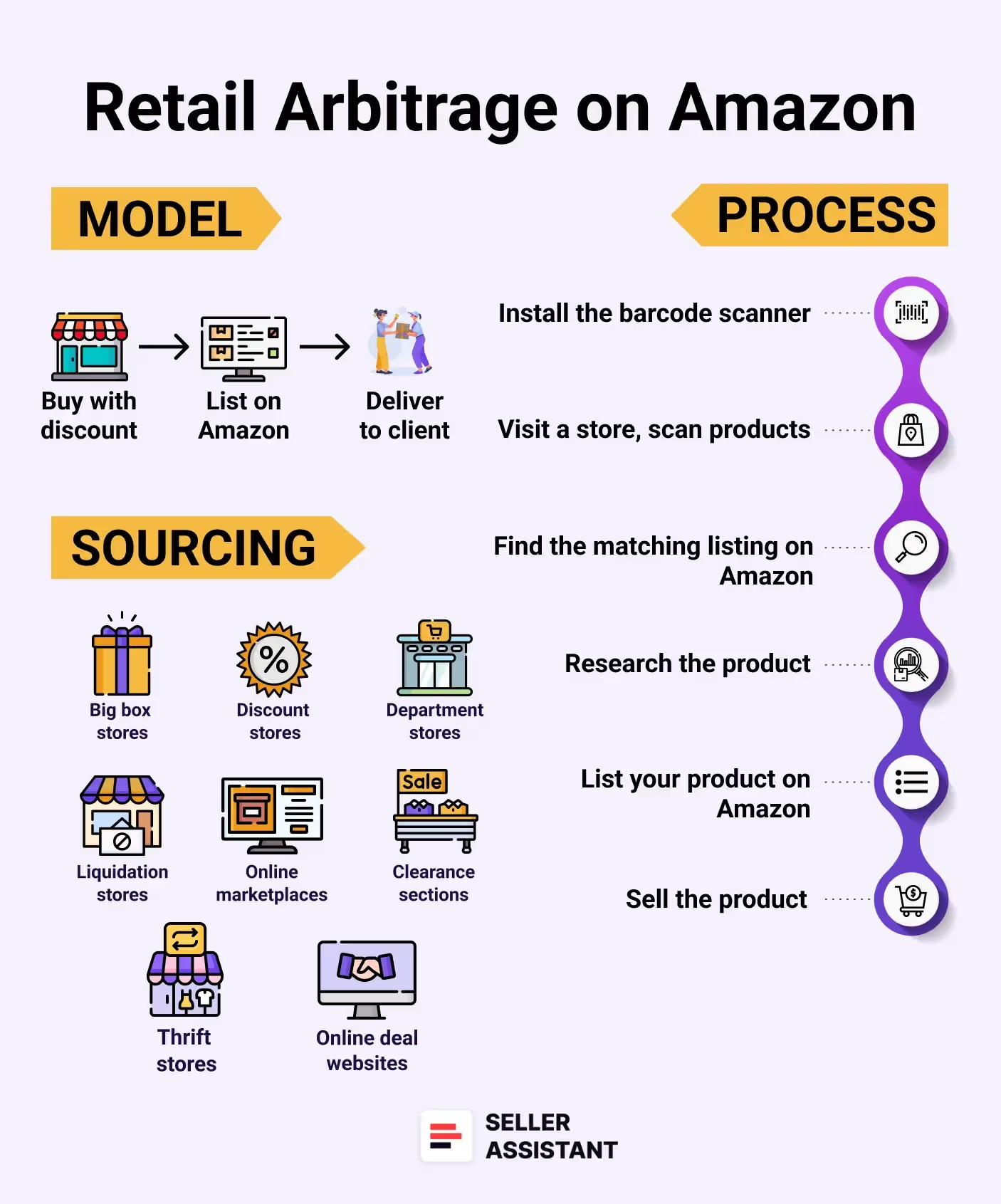
Retail arbitrage is a reselling model where you buy discounted products from physical retail stores – like Walmart, Target, or TJ Maxx – and sell them on Amazon at a profit. You earn money from the difference between what you pay in-store and what customers pay on Amazon.
How Amazon retail arbitrage works
Retail arbitrage is simple to understand but hands-on in execution. Here's how it works step-by-step.
Step 1. Set up your Amazon Seller Account
Choose the Individual or Professional plan and complete registration to access Amazon Seller Central.
Step 2. Install a barcode scanning app
Use tools like the Amazon Seller App to scan product barcodes in-store and check pricing data on Amazon.
Step 3. Visit retail stores
Shop at stores with clearance events or liquidations, scanning products to find profitable opportunities.
Step 4. Check product listings on Amazon
Make sure the item exactly matches an existing listing. Research profitability and eligibility.
Step 5. Buy your inventory
Purchase in small quantities to test items or as much as you need based on estimated sales.
Step 6. List the product on Amazon
Add your offer to the matching listing through Seller Central.
Step 7. Choose a fulfillment method
Use FBA for convenience or FBM for more control and lower fees.
Step 8. Restock manually
Once items sell, go back to stores to find more inventory and repeat the process.
3 key insights for retail arbitrage sellers
In-store product research is critical
Use scanning apps in real time to find and validate deals – guesswork is a recipe for losses.
Highly time-consuming
You’ll spend hours driving to stores, scanning items, and checking Amazon listings. It's very hands-on.
Manual restocking required
Inventory is not always replenishable – discounted products may be one-time opportunities, and you need to physically hunt for replacements.
Pros and cons of Amazon retail arbitrage
Pros
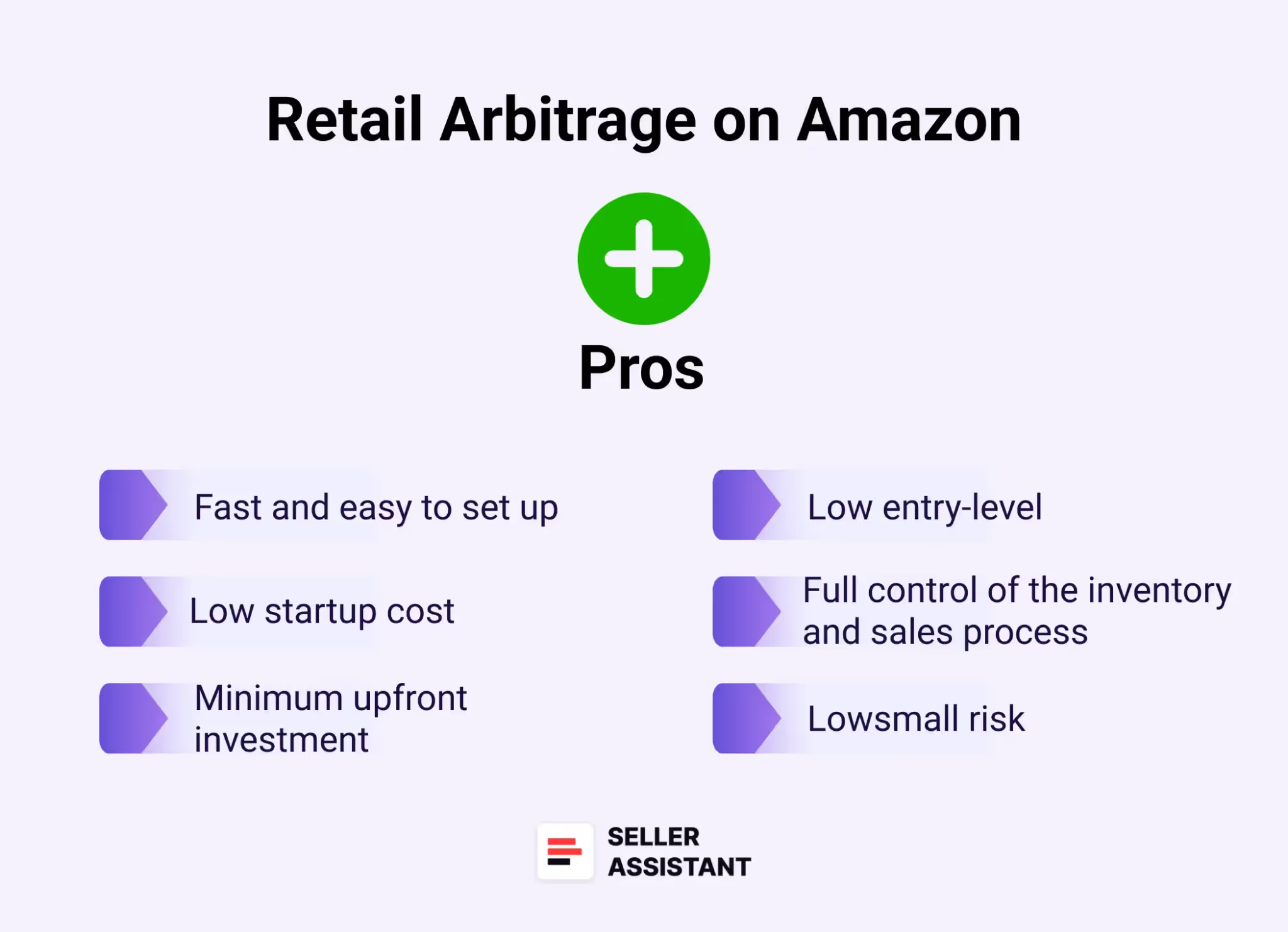
Quick and easy to set up
Retail arbitrage can be launched in days. All you need is an Amazon account, a phone, and a few trips to retail stores.
Low startup cost
You can begin with $500 or less by buying discounted items locally – perfect for sellers testing the waters.
No need for advanced skills
This model doesn’t require any special tech knowledge or previous e-commerce experience, making it accessible for beginners.
Low risk with small investment
Since you’re buying low and often selling well-known products, the chance of being stuck with unsellable stock is low.
Fast profit turnaround
Clearance and liquidation events can yield quick wins. If you find a good deal, your product can sell within days of listing.
Cons

Time-intensive sourcing
Finding and researching products takes a lot of physical effort. Expect to visit multiple stores and scan dozens of items to find one winner.
Inventory must be restocked manually
You need to revisit stores regularly, and there's no guarantee you'll find the same products or discounts again.
Difficult to scale
Your business growth is limited by how much you can personally source – especially since stock is local and often in small quantities.
Finding deals is inconsistent
Retail arbitrage depends on seasonal discounts, closeouts, or lucky finds. There’s no guarantee you’ll find profitable products every time you go out.
Hard to combine with other jobs
Due to the physical time commitment, it’s tough to manage retail arbitrage alongside a full-time job or other side hustle.
Startup Cost
Estimated starting capital: ~$500+, mainly for initial product purchases and Amazon selling fees.
Private Label
Private label is a business model where you create and sell your own branded products. Instead of reselling items made by others, you partner with a manufacturer to produce a custom product under your unique brand – giving you full control over pricing, marketing, listings, and long-term growth.
How Amazon private label works
Private label requires more setup than reselling models, but it also offers the greatest ownership and scalability. Here’s how it works.
Step 1. Identify a product niche
Use tools to find in-demand products with low to moderate competition.
Step 2. Find a manufacturer
Use platforms like Alibaba, 1688 (Chinese language platform, best used with a sourcing agent), or Global Sources to find suppliers who can produce your product, often with custom packaging and labeling.
Step 3. Customize your product
Request product modifications, logo placement, or unique packaging to make your brand stand out.
Step 4. Register your brand
Join the Amazon Brand Registry to protect your brand, gain access to A+ Content, and unlock marketing tools.
Step 5. Order your inventory
Purchase an initial batch (usually 300–1000 units) and ship it to Amazon FBA or your own warehouse.
Step 6. Create a listing
Build a new product detail page with SEO-optimized titles, bullet points, and branded imagery.
Step 7. Launch and promote
Use Amazon PPC, social media, and influencer marketing to build visibility and drive sales.
3 Key insights for private label sellers
You're building a real brand
Private label is about long-term growth, brand loyalty, and owning your customer journey – unlike reselling, where you're borrowing someone else’s product reputation.
You need upfront capital and patience
Between product development, design, inventory, and advertising, private label requires significant investment and several months before profits start rolling in.
Differentiation is crucial
Success hinges on finding a strong product idea and adding a unique twist that meets a real customer need or solves a pain point.
Pros and cons of Amazon private label
Pros of private label
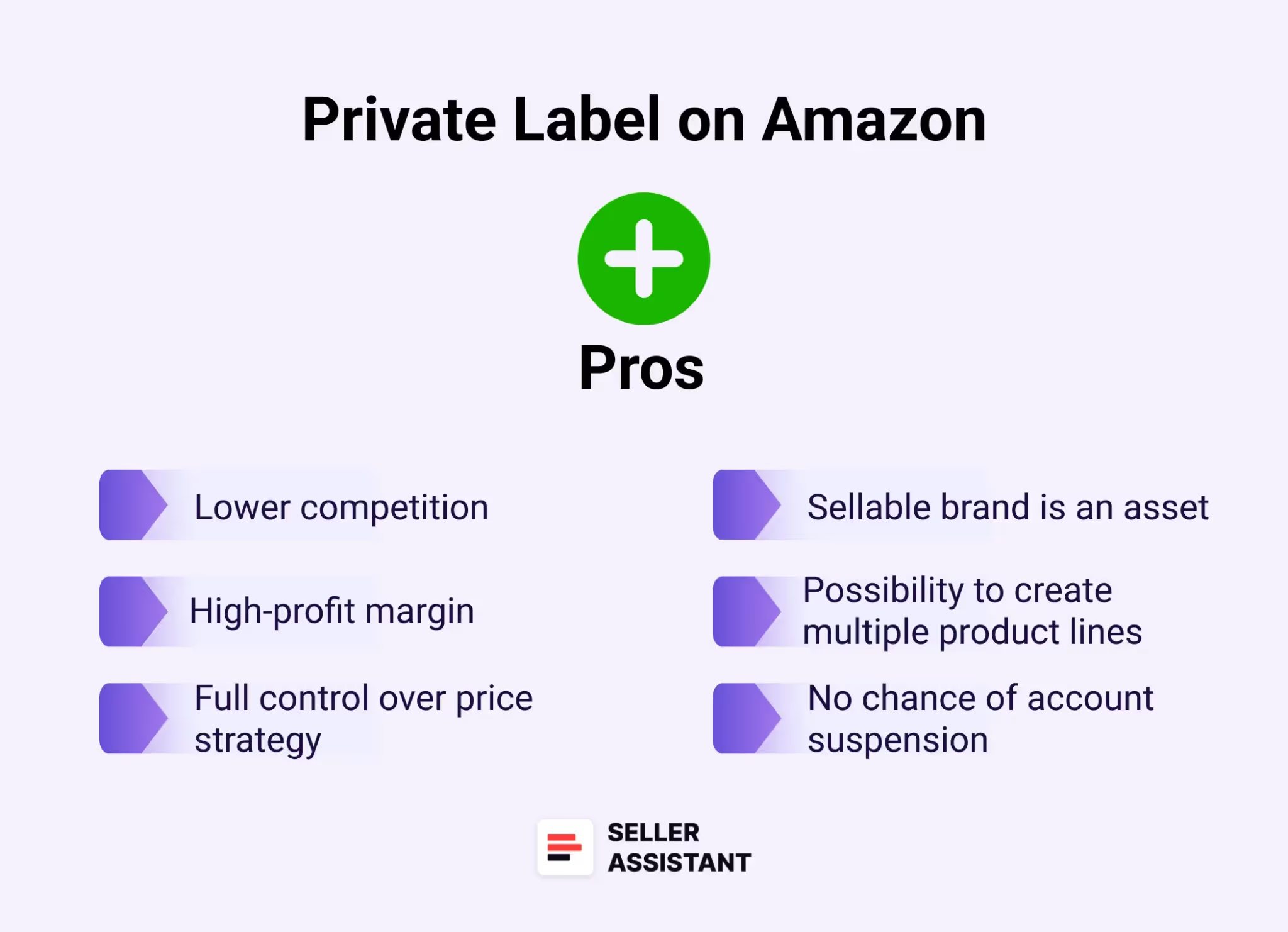
Full brand ownership
You create a proprietary product, control your listings, and set your prices without competing on someone else’s listing.
Higher profit margins
Private label sellers often enjoy 40–60%+ profit margins due to custom pricing and brand loyalty.
Scalable and sellable business
You’re building an asset – a brand – that can be expanded across product lines or even sold as a business in the future.
Access to exclusive Amazon tools
Brand Registry unlocks access to A+ Content, video ads, Sponsored Brand campaigns, and detailed brand analytics.
Control over customer experience
You decide how your product looks, how it’s packaged, and how your brand is presented – building trust and increasing repeat purchases.
Cons of private label
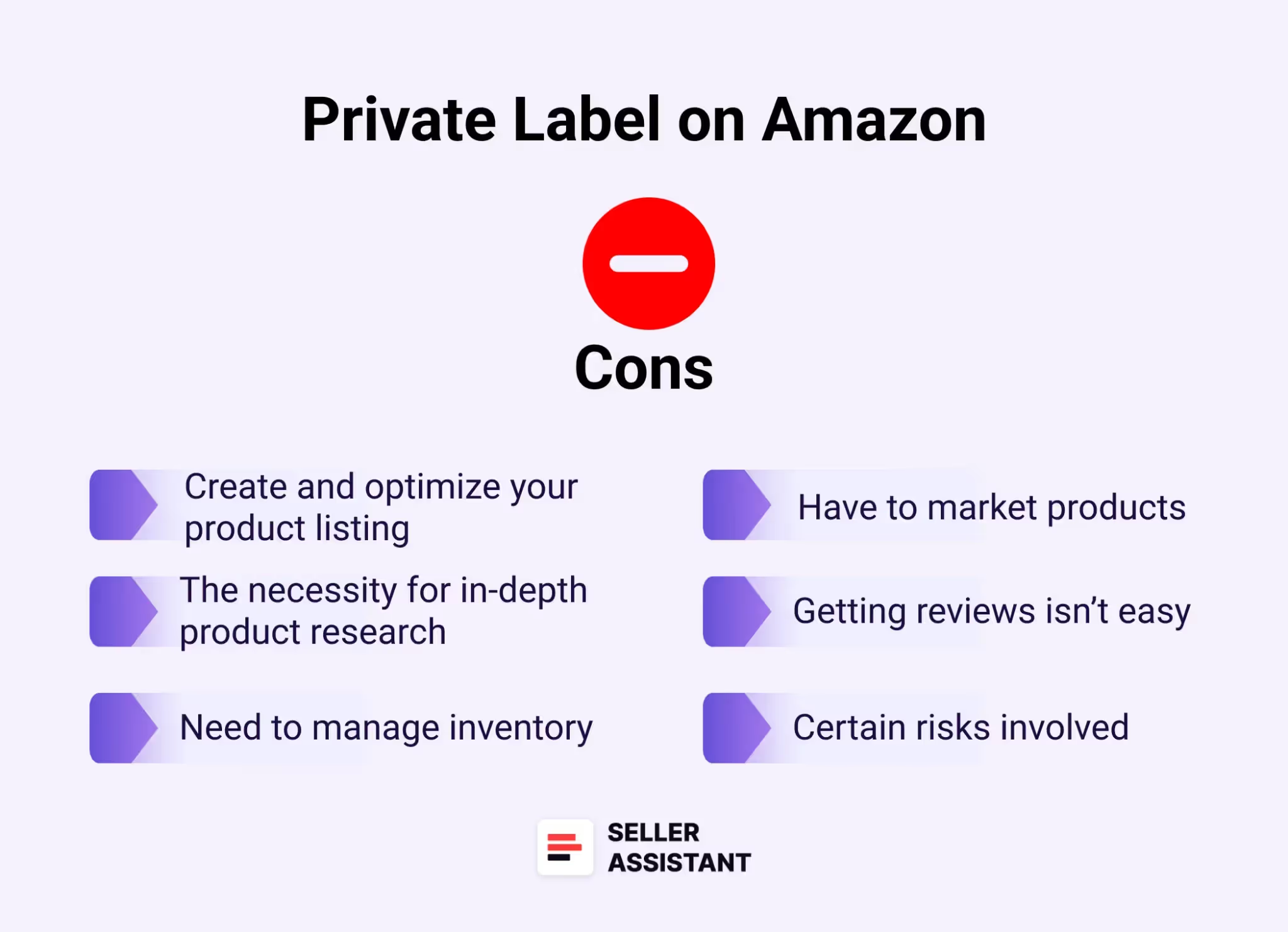
High startup costs
Expect to spend $2,000–$5,000+ upfront on product sourcing, branding, packaging, and marketing.
Longer time to profit
From research to manufacturing to marketing, it can take months before your product becomes profitable.
Requires deep market research
Success depends on choosing the right product in the right niche. Picking the wrong one can be costly and hard to recover from.
Ad spend is essential
Launching and scaling a private label product requires investing in Amazon PPC and external traffic. Without marketing, even great products won’t sell.
Inventory risk and cash flow pressure
You're buying inventory in bulk. If sales are slower than expected, your cash can get tied up – and unsold inventory can become a liability.
Startup cost
Estimated starting capital: $2,000–$5,000+, covering manufacturing, branding, listing creation, and initial advertising.
Summary Comparison Table for Amazon Business Models
How to Select an Amazon Business Model?
Choosing the right Amazon business model is one of the most important decisions you'll make as a seller. According to Jungle Scout’s data, the most popular model is private label (54%), followed by wholesale (25%), retail arbitrage (25%), online arbitrage (21%), and dropshipping (19%). This distribution highlights one key truth: there’s no one-size-fits-all. The right model for you depends on your budget, goals, available time, and risk tolerance.
Below are the key factors that should guide your decision.

Budget
Your available capital determines which models are even on the table. While dropshipping and arbitrage can start with just a few hundred dollars, private label and wholesale often require thousands upfront for inventory and branding.
Time commitment
Some models require hands-on, physical effort (like retail arbitrage), while others can be automated or outsourced (like private label or dropshipping). If your schedule is tight, choosing a model that scales without constant sourcing trips is crucial.
Experience and skill level
Beginners might benefit from low-risk, low-investment models like retail or online arbitrage. More advanced sellers with e-commerce or marketing experience may prefer private label for its long-term brand-building potential.
Control over branding
If owning your own brand and standing out from competitors is your goal, private label is the way to go. Other models, like wholesale or arbitrage, offer little to no control over branding or customer perception.
Long-term goals
Are you looking for quick cash flow or building an asset you can sell? Arbitrage and dropshipping can generate revenue quickly, while private label and wholesale offer more stability and potential for long-term growth. On the other hand, there are successful 6-figure sellers making money with online arbitrage and dropshipping, so everything depends on the right product choice.
How to Find Products for Reselling Business Models?
Finding profitable products and trustworthy suppliers for Amazon reselling can be overwhelming and time-consuming. That’s why many sellers turn to specialized software like Seller Assistant to streamline the process and uncover high-margin leads. Below are five proven strategies to help you source products more efficiently and grow your Amazon business.
Strategy 1. Automated wholesale list scanning
What it is
Automated wholesale list scanning refers to the process of analyzing large product catalogs from suppliers to uncover profitable resale opportunities. It’s a go-to strategy for wholesale and online arbitrage sellers who deal with high volumes of ASINs.
What it achieves
The main objective is to rapidly sort through bulk product data to pinpoint high-margin, low-risk products – saving hours of manual work and minimizing the risk of poor buying decisions.
How it works
With Seller Assistant's Price List Analyzer, you can upload a supplier’s wholesale price list directly into the tool. It automatically matches each item to its corresponding Amazon listing, calculates profitability, flags potential problems like excessive competition or restrictions, and delivers a wide range of actionable insights. Apply advanced filters to select high-margin low-risk deals.
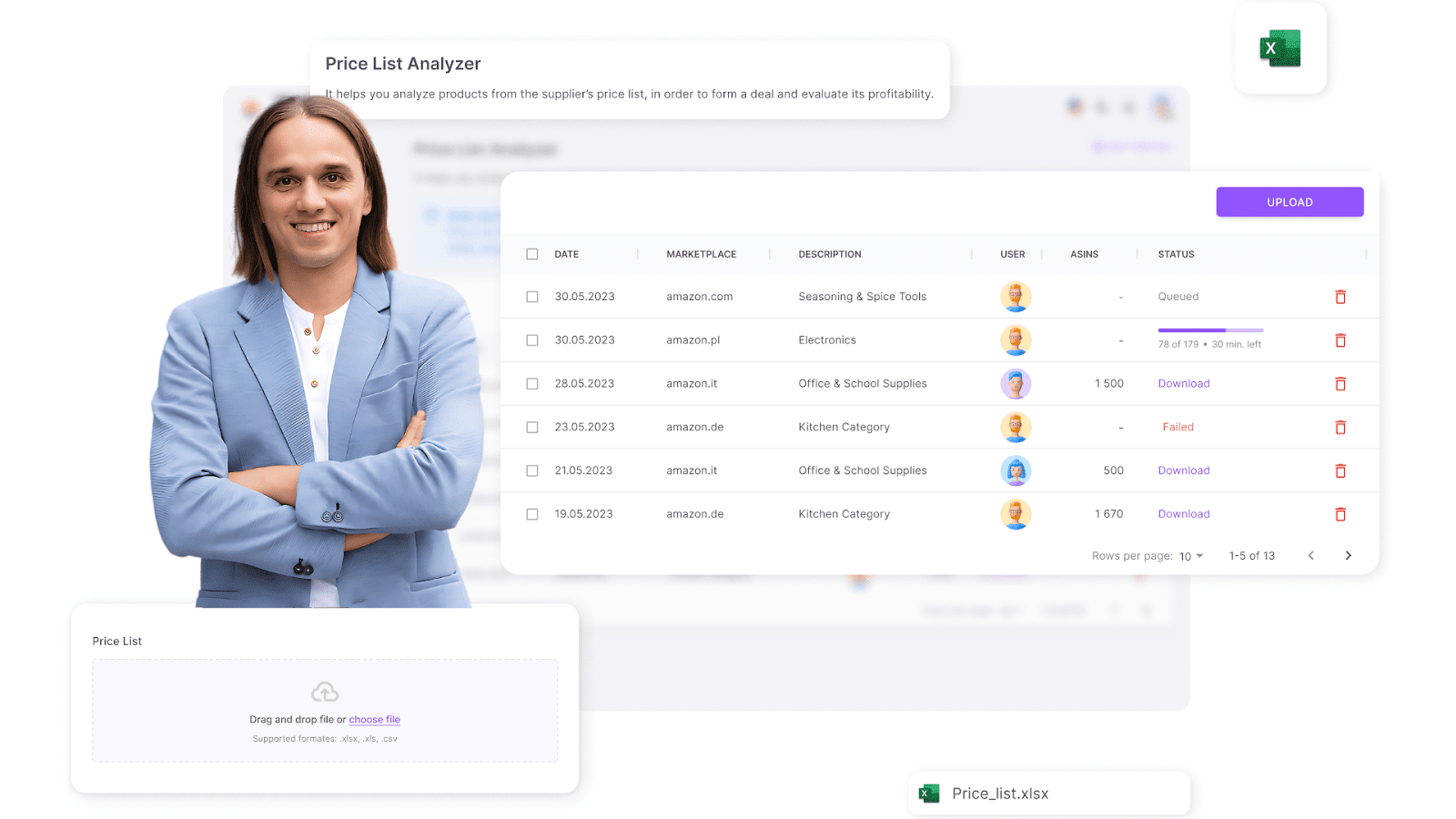
How to research effectively
- Sales Performance: Review the product’s Best Sellers Rank (BSR) to confirm steady demand.
- Competition Level: Avoid listings with over 15 sellers or where Amazon is dominant.
- Buy Box Chances: Determine who currently controls the Buy Box and assess your competitiveness.
- Pricing and Profitability: Use ROI, profit margin, and breakeven data to ensure each product is financially worthwhile.
- Restrictions: Detect IP risks and gated categories.
Who it’s good for
- Wholesale sellers working through large supplier spreadsheets or catalogs.
- Online arbitrage sellers and dropshippers scraping and scanning bulk product data from supplier websites.
Strategy 2. Automated brand research
What it is
Automated brand research is a data-driven method for finding profitable and reseller-friendly brands using digital tools. It’s especially useful for sellers who want to form long-term supplier relationships and need to evaluate brand performance before reaching out.
What it achieves
The main goal is to find brands that offer high revenue potential, manageable competition, and products that align with Amazon’s selling policies. Ideal brands also have scalable product lines, strong customer reviews, and minimal direct competition from Amazon itself.
How it works
With Seller Assistant's Brand Analyzer, you can enter any brand name to access valuable insights like average sales volume, pricing trends, number of competitors, and review quality. The tool also flags brands where Amazon dominates the listing, helping you avoid markets that are hard to compete in.

How to research effectively
- Sales Performance: Review average revenue and sales trends to assess demand.
- Competition Level: Steer clear of brands where Amazon accounts for more than 30% of sales or where there are too many third-party sellers.
- Product Range: Prioritize brands with at least 500+ SKUs – this gives you a broader selection of potentially profitable items.
- Customer Feedback: Look for brands with strong reputations (4+ star average ratings and positive reviews).
- Selling Eligibility: Use Bulk Restriction Checker to confirm you can resell the products. Just upload your product list from Brand Analyzer – green locks mean sellable, red closed locks indicate restrictions, and red locks with exclamation marks mean the product is blocked for your account.
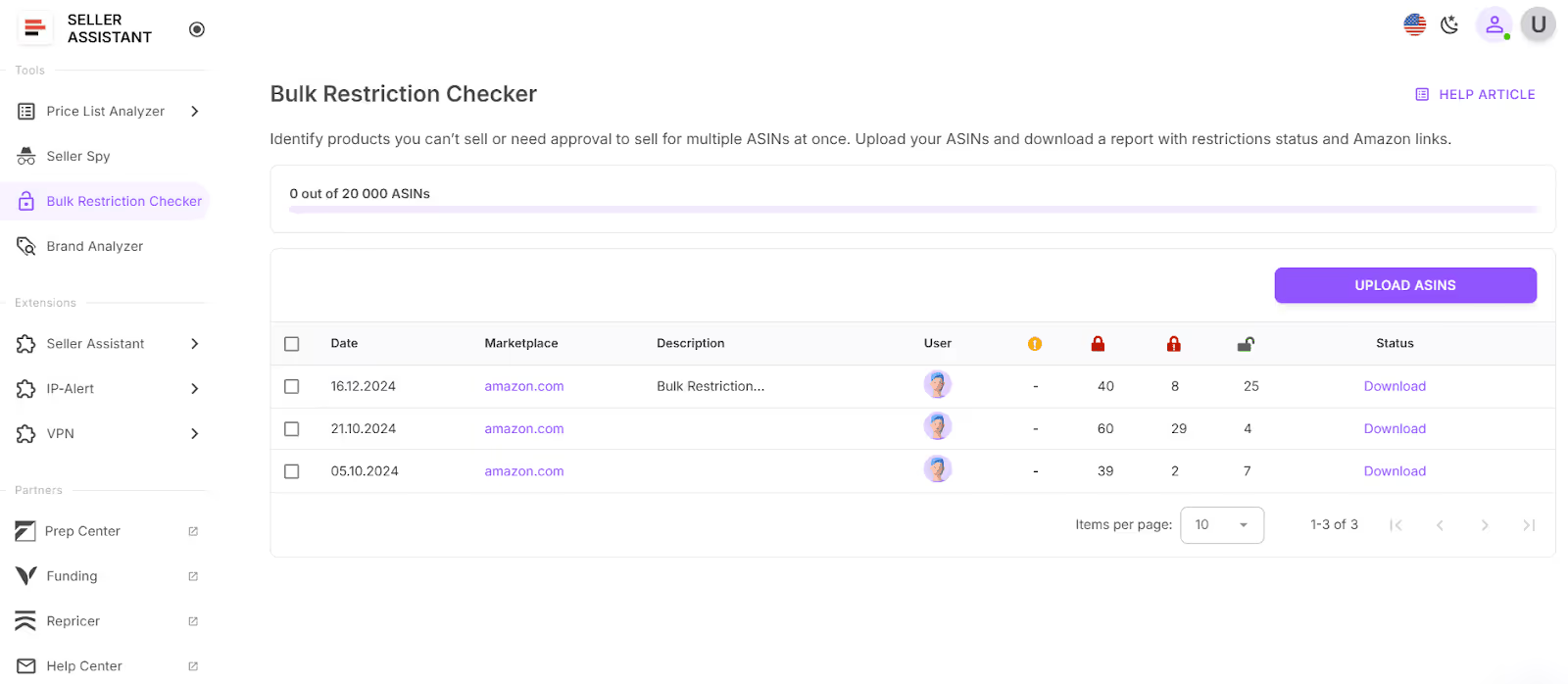
Who it’s good for
- Wholesale sellers building brand-based portfolios.
- Online arbitrage sellers and dropshippers targeting specific brands with proven market presence.
Strategy 3. Research your competitors to sell what they sell
What it is
Competitor research is the process of analyzing other Amazon sellers' product catalogs to uncover what’s already working in the market. By studying their portfolios, you can identify in-demand products and trends that are already proven to sell.
What it achieves
The goal is to spot best-selling products and brands your competitors are successfully listing – then source and sell similar or identical items yourself. This approach helps you skip guesswork and follow data-backed opportunities.
How it works
With Seller Assistant’s Seller Spy, you can track any competitor’s storefront to see what they’re currently selling, which products they’ve recently added or removed, and how they’re pricing their listings. This gives you a strategic edge to mirror winning products and fine-tune your pricing to stay competitive.
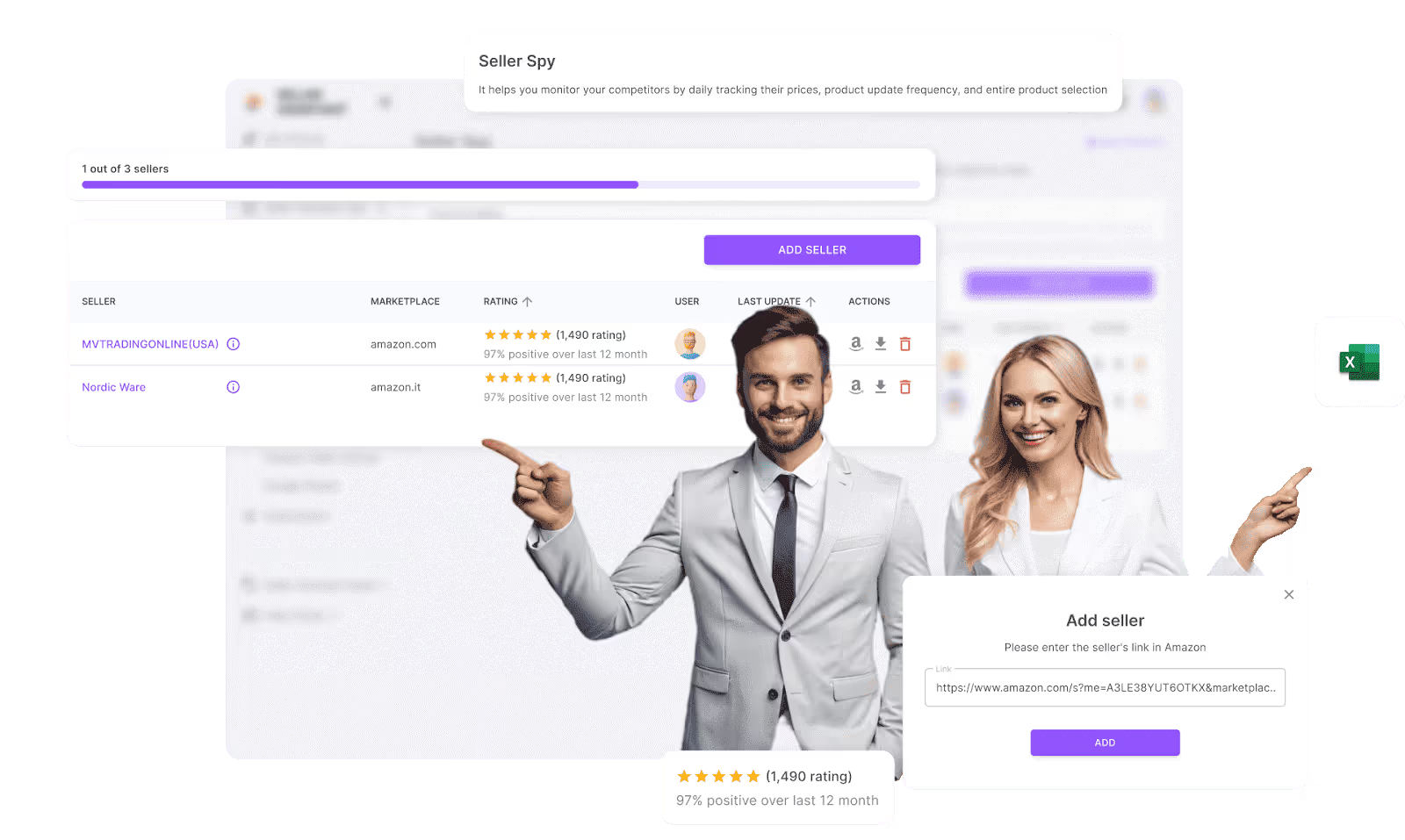
How to research effectively
- New Product Monitoring: Watch what new products competitors are adding to detect emerging trends.
- Product Removals: Learn what they’ve stopped selling – these items may be underperforming or declining in demand.
- Seller Feedback: Check customer reviews and ratings on competitor listings to gauge product satisfaction.
- Pricing Strategies: Track their pricing adjustments to maintain your competitiveness and protect profit margins.
Who it’s good for
- Online arbitrage sellers seeking data-driven sourcing ideas.
- Wholesale sellers looking to expand into proven product lines.
- Dropshippers adapting quickly to shifting trends and hot products.
Strategy 4. Find deals with in-depth product research
What it is
This strategy revolves around manually analyzing individual products to assess their profitability, competition level, and risk factors. It’s best suited for sellers who prefer a hands-on, detail-focused approach to product selection.
What it achieves
The goal is to ensure that every product you list has been thoroughly evaluated for demand, compliance, and profit potential – minimizing the risk of poor inventory decisions.
How it works
Using the Seller Assistant Extension, you gain real-time access to key data across Amazon search and product pages, supplier websites, and competitor storefronts. The tool displays sales performance, profitability metrics, competitive landscape, and risk warnings – everything you need to make informed sourcing choices.

How to research effectively
- Sales Performance: Review Best Sellers Rank (BSR) – ideally between 1 and 200,000 – along with sales trends and history to confirm demand consistency.
.avif)
- Competition Analysis: Check how many FBA and FBM sellers are on the listing (2–15 is ideal). Use the Offers feature in Seller Assistant to view detailed seller info, including stock and prices.
.avif)
- Amazon’s Presence: Look for the red Amazon icon, which indicates Amazon itself is selling the product. Competing with Amazon often means losing the Buy Box – avoid these listings when possible.
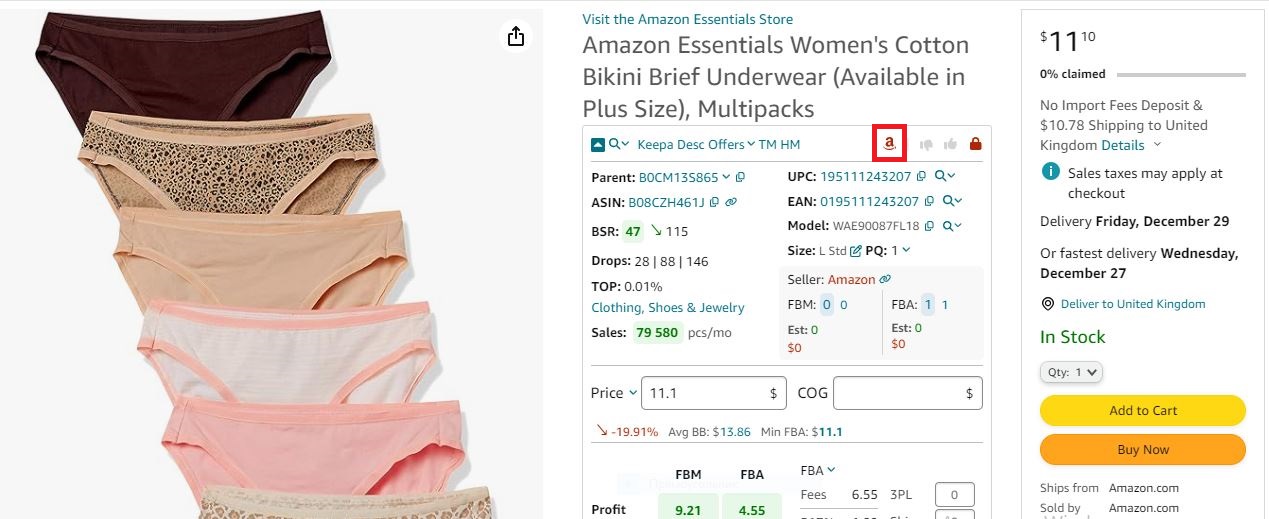
- Profitability Metrics: Use the built-in FBA&FBM profit calculator to analyze ROI, profit margins, and breakeven points.
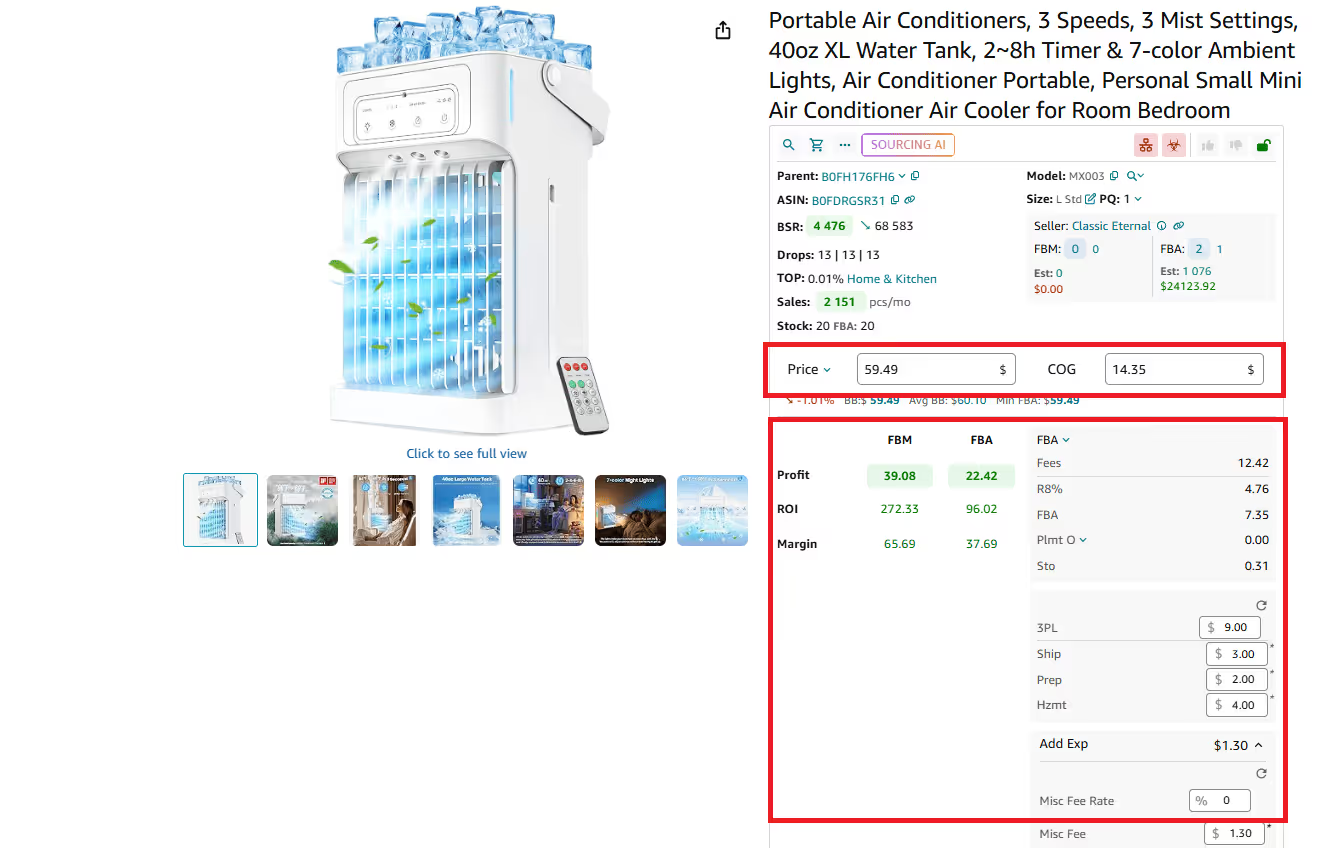
- Risk Assessment: Flag potential issues like product restrictions, IP complaints, or risky product types (fragile, oversized, hazmat, etc.).

- Historical Data: Refer to integrated Keepa charts to review long-term pricing and sales patterns. Be cautious with new listings that lack long-lasting sales history (must be at least half a year to 1 year and up) – they may not perform as expected.

Who it’s good for
- Online arbitrage sellers who require a granular view of product performance and risks.
- Dropshippers doing manual product sourcing and needing detailed validation before listing.
- Wholesale sellers who need to manually verify single questionable deals.
Strategy 5. Automate supplier hunting with Sourcing AI
What it is
This strategy uses Sourcing AI by Seller Assistant to instantly find verified U.S. suppliers for any Amazon product. Instead of Googling listings or scanning endless supplier sites, it delivers a table of up to 10 matching sources based on ASIN, UPC, model number, or brand – directly inside your sourcing workflow.
%20(1)%20(1).avif)
What it achieves
It removes hours of manual work and sourcing guesswork. You get accurate supplier links, pricing, SKU, MOQ, and match confidence – all in seconds. The tool also flags overpriced items and misaligned multipacks, helping you avoid sourcing mistakes.
How it works
You simply open an Amazon product or search page and click the “Sourcing AI” button in the Seller Assistant Extension. It pre-fills the product’s data and Max COG into ChatGPT and returns a real-time table of verified U.S. supplier offers. Each result is labeled as an Exact or Likely Match, with price, availability, and direct links.
How to use it effectively
Product identifiers: Use ASIN, UPC, model number, or brand name for precise product matching and to avoid sourcing the wrong variation.
Max COG filtering: Enter your maximum cost of goods to automatically exclude overpriced suppliers that won’t meet your margin goals.
Match accuracy: Prioritize “Exact Match” results and double-check “Likely Matches” to avoid sourcing errors like pack size mismatches.
Supplier details: Review SKUs, prices, and minimum order quantities (MOQs) directly in the result table to speed up supplier outreach.
Bundling warnings: Watch for alerts on multipacks or bundles that may not match the Amazon listing’s unit count.
Pricing insight: Compare Amazon pricing to supplier prices side-by-side in the same view to quickly validate resale potential.
Who it’s good for
- Wholesale sellers looking to find official U.S. distributors quickly.
- Online arbitrage sellers needing fast product-to-supplier matching from Amazon pages.
- Dropshippers who want to validate supplier options instantly while browsing listings or storefronts.
Final Thoughts
Choosing the right Amazon business model is the foundation of your success as a seller. Whether you’re looking for quick profits, long-term brand growth, or a low-risk entry into e-commerce, there’s a model that matches your budget, skills, and goals. Each path – wholesale, arbitrage, dropshipping, or private label – comes with unique pros, challenges, and opportunities.
The key is to start where you are and scale smart. Use tools like Seller Assistant to make informed decisions, minimize risk, and streamline your workflow. The best Amazon sellers aren’t the ones who know everything from day one – they’re the ones who start, learn fast, and keep improving.
Seller Assistant is an all-in-one product sourcing software offering all the features vital for product sourcing. It combines three extensions: Seller Assistant Extension, IP Alert, and VPN by Seller Assistant, tools: Price List Analyzer, Seller Spy, Bulk Restrictions Checker, and API integrations, and features: Side Panel View, FBM&FBA Profit Calculator, Quick View, ASIN Grabber, UPC/EAN to ASIN converter, Stock Checker, and other features that help quickly find high-profit deals. Seller Assistant also offers integration with Zapier allowing to create custom product sourcing workflows.
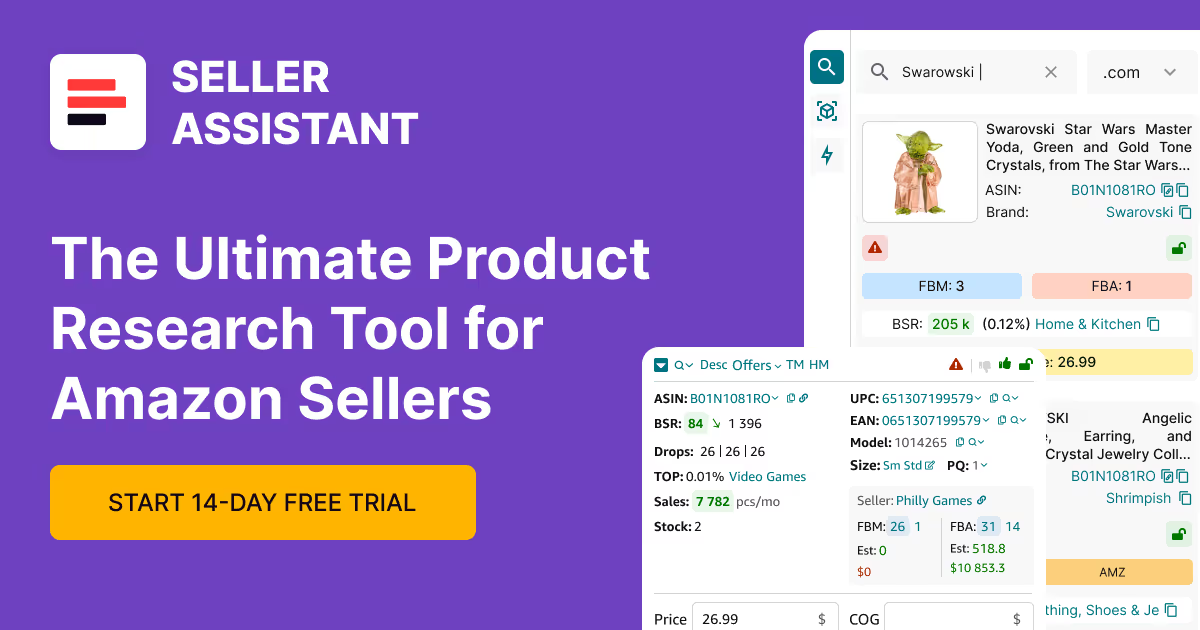
.svg)













